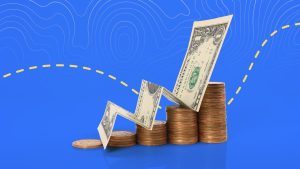Michael M. Santiago / Staff/Getty Images
Key takeaways
- The Federal Reserve is widely expected to cut its benchmark rate in coming months, and APYs on competitive savings accounts could fall, in turn.
- For the time being, savers are enjoying APYs that are higher than they’ve been in more than a decade, outside the current rate cycle.
- High-yield savings accounts continue to earn APYs well above 4 percent, and many don’t require a minimum balance or come with other strings attached.
This year, the Federal Reserve has been in a holding pattern that’s spanned five straight rate-setting meetings, keeping its benchmark rate in a target range of 4.25-4.5 percent. As a result, consumers with competitive savings accounts continue to enjoy juicy rates above 4 percent annual percentage yield (APY).
The best high-yield savings account rates could retreat, however, if policymakers decide to cut the federal funds rate in coming months. In fact, interest rate traders overwhelmingly believe the Fed will pare back rates in September, according to data from CME Group. This comes after Treasury Secretary Scott Bessent told Bloomberg TV last week he believes there’s “a very good chance of a 50 basis-point rate cut” next month.
Bessent’s prediction is the equivalent of half a percentage point drop, making the fed funds rate a range of 3.75-4.0 percent. As of the publication of this article, CME Group data shows the majority of traders anticipating a range of 4-4.25 percent — 25 basis points, or a quarter of a percentage point, lower — with a small minority predicting rates won’t budge at all from the current range come the Fed meeting in September.
Yields on savings accounts, money market accounts and CDs haven’t changed a lot so far in 2025, pulling back very modestly. But, this will accelerate into a faster decline if the Fed intends to cut interest rates more than once in the remaining months of the year.
— Greg McBride, CFA | Bankrate Chief Financial Analyst
Today’s best savings account rates
Peak Bank remains the leader when it comes to top-notch rates, among banks reviewed by Bankrate’s editorial team. While it lowered its APY at the start of August, its current rate of 4.35 percent APY remains the highest, with three banks slightly trailing at 4.30 percent APY.
Note: Annual percentage yields (APYs) are as of Aug. 18, 2025. APYs for some products may vary by region.
Latest news from the Federal Reserve
The Federal Reserve is tasked with a dual mandate of promoting stable prices and maximum employment. To achieve these two goals, the Fed sets monetary policy by adjusting rates. Historically, officials have raised rates in attempts to bring down inflation, while they’ve lowered rates to help prop up a weakening job market.
Currently, Fed policymakers are faced with challenges involving both components of the central bank’s mandate:
- Above-target inflation: In July, consumer prices were up at an annual rate of 2.7 percent, per data released last week by the Bureau of Labor Statistics (BLS). This figure was unchanged from June’s annual rate of increase. The Fed’s stated inflationary target is 2 percent.
- Weakening jobs market: In July, the unemployment rate ticked up to 4.2 percent, per the BLS. The agency also reported the U.S. added a seasonally adjusted 73,000 jobs in July, which fell short of economists’ expectations.
“It appears increasingly likely the Fed will cut rates two or perhaps even three times as we close out 2025, as risks to the employment market come into balance with risks that inflation exceeds the Fed’s 2 percent target,” says William Merz, head of capital markets research for U.S. Bank Asset Management Group. “That’s because a balanced set of risks supports a neutral policy stance, compared to the slightly restrictive level of interest rates right now.”
Banks often modify their APY offerings in response to Fed rate changes, with some institutions reacting sooner or later than others, Merz says.
Historically, Fed rate cuts (and hikes) tend to impact things like the rate on high-yield savings accounts relatively quickly, but some institutions may move faster than others.
— William Merz, CFA | Head of capital market research, U.S. Bank Asset Management Group
How to preserve your high APY in a falling-rate environment
Officials have left the federal funds rate unchanged in 2025, to date, which has spurred some stability in competitive deposit account rates. That noted, the top high-yield savings account’s APY has inched down — by around 15 basis points, or 0.15 percentage-point, since the spring — based on accounts monitored by Bankrate’s editorial team. APYs could retreat further as we approach an upcoming potential Fed rate cut, as well as in its aftermath.
Consider a CD
A bank account that lets you lock in one of today’s high APYs is a certificate of deposit (CD). Right now, the best CD rates are well above 4 percent APY, higher than APYs of top high-yield savings accounts. The difference is that CDs typically have fixed APYs that remain the same for the duration of their terms — even if going rates on new accounts were to drop.
While the guaranteed rate can be a plus, one caveat is CDs usually come with early withdrawal penalties if you take the money out before the term ends. This penalty would eat into your interest and possibly even your principal. As such, money you may need for emergencies is better off in a liquid savings account.
Bottom line
Expectations are that the Federal Reserve will cut the federal funds rate in coming months. APYs on many high-yield savings accounts could decrease, in turn. For now, savers can still earn yields north of 4 percent APY, and some could benefit from locking in a high CD rate now should APYs retreat further. However, before locking money in a CD, you should have a healthy emergency fund in a liquid savings account.
Why we ask for feedback
Your feedback helps us improve our content and services. It takes less than a minute to
complete.
Your responses are anonymous and will only be used for improving our website.
Help us improve our content
Read the full article here









